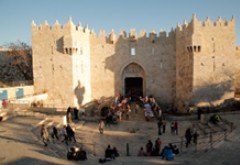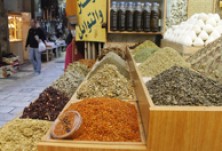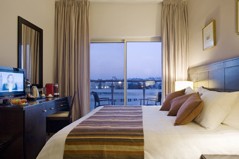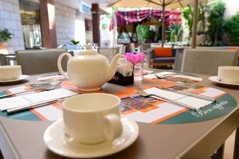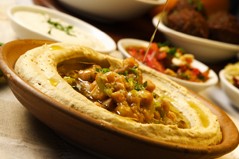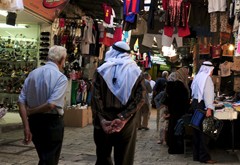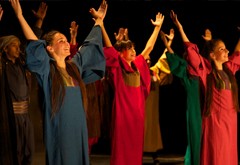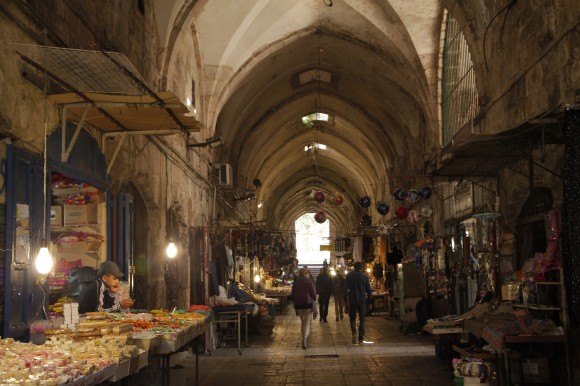The easiest way to move from Khan al-Sultan to Suq al-Qattanin is to walk down Bab al-Silsilah Street towards al-Aqsa Mosque, leaving the Khan and heading east (left), then following the Hakari Street to ‘Aqabat al-Khalidiyya, where, at the eastern end, is the western entrance to Suq al-Qattanin. It is possible to continue walking down Bab al-Silsilah Street to the next junction at Daraj al-‘Ain crossing. The end of this street leads to the entrance of Suq al-Qattanin.
Position and Names of Suq Al-Qattanin
This Suq is considered one of the most complete and beautiful Suqs in Palestine. Creswell, the Islamic architecture scholar, considered it one of the most spectacular Suqs in the Levant. Mujir aDin, the historian of Jerusalem and Hebron, praised it at the beginning of the 10th century AH (16th century AD), saying: ‘As for places in noble Jerusalem whose buildings are tightly and perfectly built, Suq al-Qattanin, standing adjacent to the Mosque’s gate to the west, is very tall and perfectly constructed, and there are not many like it in other countries.’
Location and Names
Suq al-Qattanin is among the most famous Suqs in Jerusalem. It is adjacent to al-Aqsa Mosque and leads to it from the western side. In fact, it represents a vital connecting point between al-Aqsa Mosque and al-Wad Street. The current name, Suq al-Qattanin, is not its original name, but dates back to the 15th century AD/10th century H, when the Suq was famous for the sale of cotton and its derivatives. Sometimes, locals refer to it as the ‘dark Suq’ due to the variance in light compared to the open parts of al-Aqsa Mosque. It should be more rightly named after the person who built it, Prince Tankiz al-Nasiri, the powerful Levant commissioner (737 AD/1336-1337 H).
Suq Facilities
Suq al-Qattanin contains a Khan (caravanserai) and two baths, and extends 95 meters from east to west. It is flanked, north and south, by two lines of shops, with thirty shops in each on the first level. The second level contains 60 private areas for visitors and travelers to stay. The Khan contains offices for the Islamic Awqaf Department (Islamic trust for managing edifices, mainly of al-Aqsa Mosque), and the Jerusalem (al-Quds) University.
Founder of the Suq
The Suq, effectively a commercial center, was built during the reign of Sultan al-Malek Al-Nasir Muhammad Ibn Qalawun, whose architectural contributions to Jerusalem surpassed the activities of any other Mamluk Sultan. It was built by Tankiz Al-Nasiri, the Levant commissioner in 1336-1337 AD/737 H. The income from Suq al-Qattanin was allocated on a 50-50 basis between the Aqsa Mosque Waqf and the Tankiziyya School.
Architectural Description of the Suq
The Suq is covered by a series of cross vaults, dividing the roof into 30 square space, with an opening in each for illumination and ventilation. The Suq has two entrances from the east and west, with the eastern one forming one of the Haram’s (Noble Sanctuary’s) important gates. It was built with great care and is truly an architectural marvel. It is composed of an arch with a three part lintel, surrounded by another receding half-circular arch supported by five staggered stone stalactites (muqarnasat). The gate’s interlocking stones were carefully laid in red, black and grey (Ablaq), a common arrangement in Jerusalem’s Islamic architecture, especially in Mamluke structures. Its western wall is simpler in its architectural design, comprising an elongated opening covered by a straight cover of seven interlocking stone systems, topped by a receded cover and a circular opening. Al this is housed in a long dome with a pointed end.
Suq al-Qattanin, like other Suqs of the Holy City, has lost its specialization in the trading of cotton. Today, the Suq offers all kinds of gifts and artifacts, rosary beads, souvenirs and clothes for visitors to al-Aqsa Mosque and the Old City.

